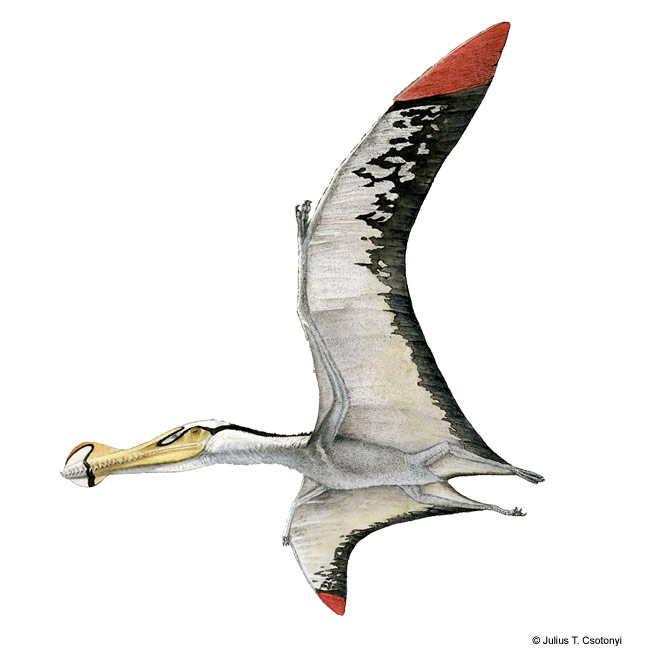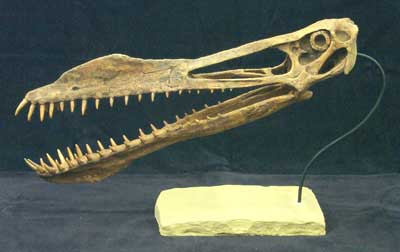[Recent Entries][Archive][Friends][User Info]
April 23rd, 2014
| April 23rd, 2014 | |
|---|---|
| 10:48 am [industrialterro] [Link] |
Alanqa Alanqa (от араб. «Al Anqa» — феникс) — вымерший род птеродактелей, обитавший в меловом периоде примерно 95 млн лет назад. Ископаемые останки были найдены в отложениях сеноманского яруса в Марокко и описаны в 2010 году. Единственный известный вид — Alanqa saharica Ibrahim et a., 2010. Название птеродактиля Alanqa saharica происходит от арабского слова «Al Anqa», которое означает «Феникс», а видовое название saharica указывает на то, что данный вид был обнаружен в пустыне Сахара. Описание A. saharica основано на исследовании челюстной кости длиной 344 мм, составленной из трёх отдельных фрагментов. Также были найдены фрагменты шейных позвонков, принадлежавших, вероятно, A. saharica. Длина птеродактеля составляла примерно шесть метров. Отличительной особенностью A. saharica является отсутствие зубов. Является одним из древнейших известных представителей семейства аждархид. Окаменелости птерозавра находились на территории древней Гондваны (на территории современного Марокко), однако подавляющее большинство сравнимых по возрасту экземпляров аждархид было обнаружено на землях бывшей Лавразии. Так же рядом с останками Alanqa были обнаружены 2 других вида птерозавров, что свидетельствует о тесном соседстве разных видов птерозавров на одной территории и на одном промежутке времени. Aided by local villagers, a team of paleontologists had been excavating at several locations in the Kem Kem Beds during April, and November to December 2008, uncovering remains of several different pterosaurs. The material was fragmentary, and the type locality for Alanqa is Aferdou N'Chaft, near the village of Begaa and 10 km to the north-east of Taouz. Alanqa is known only from five fragments of the front upper and lower jaws, and possibly a neck vertebra, representing the single type species Alanqa saharica. Two of these fragments were first described, but not named, by Wellnhofer and Buffetaut in 1999. Three additional jaw specimens, including a better preserved upper jaw, were described and named by Ibrahim and colleagues in 2010. The jaws were straight and pointed, like those of Quetzalcoatlus and Zhejiangopterus, so while it was originally proposed as a pteranodontid, it is more likely Alanqa was an azhdarchid. Based on comparison to related species, the Alanqa saharica the individuals known from jaw specimens probably had wingspans of about 4 meters (about 13 ft). However, according to Ibrahim and colleagues, the vertebra (which probably belonged to the same species) appeared to come from a larger individual, measuring about 6 meters (about 20 ft) in wingspan. ( Read More ) Tags: Вымершие рептилии, Мел, авеметатарзалии, аждархиды, аждархойды, архозавроморфы, архозавры, диапсиды, монофенестраты, орнитохейройды, птеродактили, птерозавры |
| Time | Event |
| 12:56 pm [industrialterro] [Link] |
Arambourgiania Arambourgiania is a pterosaur from the Late Cretaceous (Maastrichtian) of Jordan. It was one of the largest members of this group. In the early forties, a railway worker during repairs on the Amman-Damascus railroad near Russeifa found a two feet long fossil bone. In 1943 this was acquired by the director of a nearby phosphate mine, Amin Kawar, who brought it to the attention of a British archeologist, Fielding, after the war. This generated some publicity — the bone was even shown to Abdullah I of Jordan — but more importantly, it made the scientific community aware of the find. In 1953 the fossil was sent to Paris, where it was examined by Camille Arambourg of the Muséum national d'histoire naturelle. In 1954, he concluded the bone was the wing metacarpal of a giant pterosaur. In 1959, he named a new genus and species: Titanopteryx philadelphiae. The genus name meant "titan wing" in Greek; the specific name refers to the name of Amman in Antiquity: Philadelphia. Arambourg let a plaster cast be made and then sent the fossil back to the phosphate mine; this last aspect was later forgotten and the bone was assumed lost. In 1975 Douglas A. Lawson, studying the related Quetzalcoatlus, concluded the bone was not a metacarpal but a cervical vertebra. In the eighties, Russian paleontologist Lev Nesov was informed by an entomologist that the name Titanopteryx had already been given by Günther Enderlein to a fly from the Simulidae family in 1934. Therefore, in 1987 he renamed the genus into Arambourgiania, honouring Arambourg. However, the name "Titanopteryx" was informally kept in use in the West, partially because the new name was assumed by many to be a nomen dubium. Early 1995, paleontologists David Martill and Eberhard Frey traveled to Jordan in an attempt to clarify matters. In a cupboard of the office of the Jordan Phosphate Mines Company they discovered some other pterosaur bones: a smaller vertebra and the proximal and distal extremities of a wing phalanx — but not the original find. However, after their departure to Europe engineer Rashdie Sadaqah of the mine investigated further and in 1996 established it had been bought from the company in 1969 by geologist Hani N. Khoury who had donated it in 1973 to the University of Jordan; it was still present in the collection of this institute and now could be restudied by Martill and Frey. The holotype, VF 1, consists of a very elongated cervical vertebra, probably the fifth. Today the middle section is missing; the original find was about 62 centimetres long, but had been sawed into three parts. Most of the fossil consists of an internal infilling or mould; the thin bone walls are missing on most of the surface. The find had not presented the whole vertebra; a piece was absent from its posterior end as well. Frey and Martill estimated the total length to have been 78 centimetres, using for comparison the relative position of the smallest shaft diameter of the fifth cervical vertebra of Quetzalcoatlus. From this again the total neck length was extrapolated at about three metres. From the relatively slender vertebra the length dimension was then selected to be compared to that of Quetzalcoatlus, estimated at 66 centimeters long, resulting in a ratio of 1.18. Applying that ratio to the overall size, Frey and Martill in 1998 concluded that the wingspan of Arambourgiania had been twelve to thirteen metres, compared with the ten to eleven metres of Quetzalcoatlus, and that Arambourgiania was thus the largest pterosaur then known. Later estimates have been more moderate, sometimes as low as seven metres. Frey and Martill rejected the suggestion that Arambourgiania was a nomen dubium or identical to Quetzalcoatlus and affirmed its validity in relation to "Titanopteryx". Nesov in 1984 had placed the species within Azhdarchinae, part of the Pteranodontidae; the same year Kevin Padian placed it within Titanopterygidae. Both concepts have fallen into disuse now that such forms are commonly assigned to the Azhdarchidae.
Tags: Вымершие рептилии, Мел, авеметатарзалии, аждархиды, аждархойды, архозавроморфы, архозавры, диапсиды, монофенестраты, орнитохейройды, птеродактили, птерозавры |
| Time | Event |
| 01:42 pm [industrialterro] [Link] |
Anhanguera Anhanguera (meaning "old devil") is a genus of pterodactyloid pterosaur known from the Lower-Cretaceous (Aptian age, 112Ma) Santana Formation of Brazil, with referred specimens found in the Upper Chalk Formation and Cambridge Greensand of the UK (up to the late Cenomanian age, 94Ma). This pterosaur is closely related to Ornithocheirus, and belongs in the family Ornithocheiridae within its own subfamily, Anhanguerinae. Anhanguera was a fish-eating animal with a wingspan of about 4.5 m (15 ft). Like many other ornithocheirids, Anhanguera had a rounded crests at front of its upper and lower jaws, which were filled with angled, conical but curved teeth of various sizes and orientations. Like many of its relatives, the jaws were tapered in width, but expanded into a broad, spoon-shaped rosette at the tip. It is distinguished from its relatives by subtle differences in the crest and teeth: unlike its close relatives Coloborhynchus and Ornithocheirus, the crest on the upper jaw of Anhanguera did not begin at the tip of the snout, but was set farther back on the skull. Like many ornithocheiroids, (most notably the pteranodonts but also in ornithocheirids such as Ludodactylus) Anhanguera had an additional crest protruding from the back of the skull. However, it was reduced to a small, blunt projection in these animals. A study in 2003 showed that Anhanguera held its head at an angle to the ground due to its inner ear structure, which helped the animal detect its balance. There are several recognized species of Anhanguera. A. santanae and A. blittersdorfi are known from several fragmentary remains including skulls from the Santana Formation of Brazil. A. cuvieri and A. fittoni, initially described as belonging to the genus Pterodactylus and then Ornithocheirus, are from a slightly later period (Albian) from England, while fragments of pterosaurs that may have affinities with Anhanguera have also been found in Queensland, Australia. The well-known species A. piscator has been redescribed as belonging to the genus Coloborhynchus (Veldmeijer, 2003). Anhangueridae is a group of pterosaurs within the suborder Pterodactyloidea. They were among the last pterosaurs to possess teeth. A recent study discussing the group considered the Anhangueridae to be typified by a premaxillary crest and a lateral expansion in the distal rostrum. The same study presented a cladistic analysis, for which an "Agreement subtree" was calculated. The Anhangueridae was found to be sister taxon to the large crested "Tropeognathus". ( Read More ) Репродукции (1, 2, 3, 4, 5, 6, 7, 8): ( Read More ) Ископаемые останки (1, 2, 3, 4, 5): Tags: Вымершие рептилии, Мел, авеметатарзалии, аньянгуэриды, архозавроморфы, архозавры, диапсиды, монофенестраты, орнитохейройды, птеранодонтойды, птеродактили, птерозавры |
| Previous Day | 2014/04/23 [Archive] |
Next Day |
















